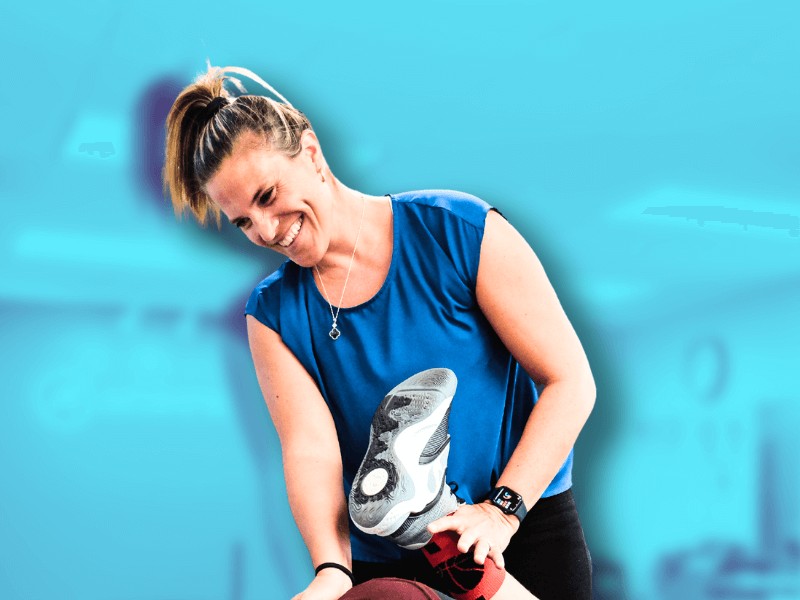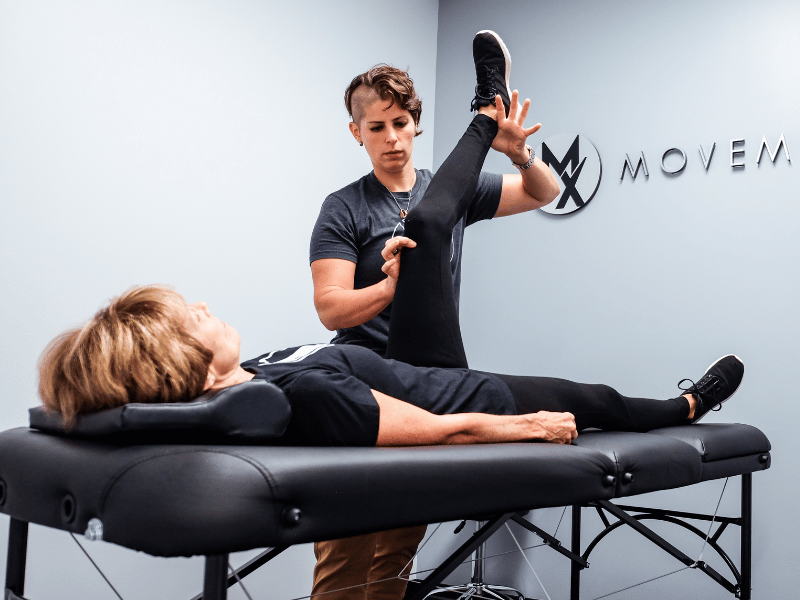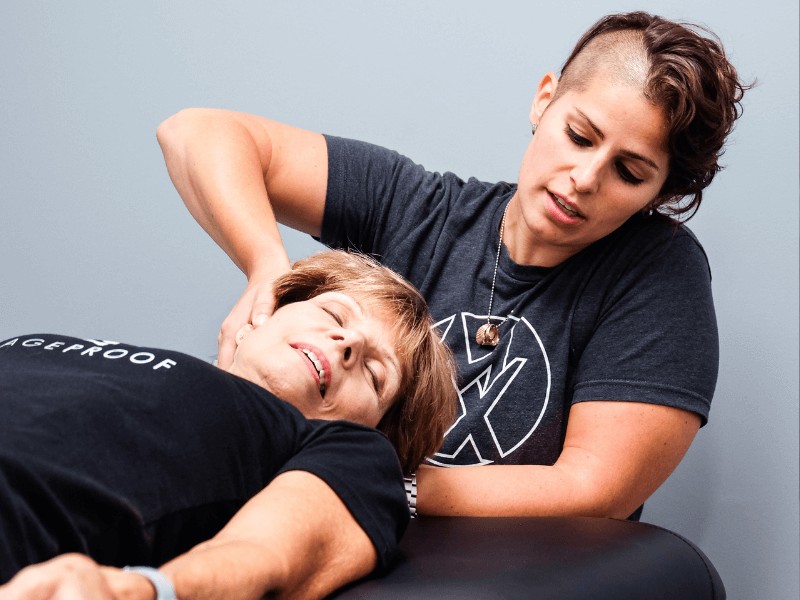From Injury to Performance: Overcoming Ankle Pain and Injuries
Ankle pain, often resulting from an injury, is a common issue that affects people of all ages and backgrounds. It can significantly impact daily activities and overall quality of life. Whether you've awkwardly stepped off a curb, twisted your ankle in a grass divot, or sustained a sports-related injury, addressing ankle pain early is crucial for better recovery outcomes and a quicker return to an active lifestyle.
Despite the unexpected nature of most ankle injuries, it is essential to highlight the importance of foot and ankle strength. The ankle bears a significant amount of weight and stress daily. This complex structure, composed of bones, ligaments, tendons, muscles, cartilage, and synovium, works together to provide support, stability, mobility, proprioception, impact absorption, force production, and the ability to store and release energy.
According to the American Academy of Orthopaedic Surgeons (AAOS), lateral ankle sprains are among the most common ankle injuries, accounting for a large proportion of sports-related injuries and being a significant reason people seek medical care. Ensuring good ankle and foot strength involves proactive measures to develop relative stiffness through the 3 arches of the foot, maintaining mobility AND integrity of the foot's rigid lever arm, while also addressing injuries promptly to avoid long-term complications. Proper care helps maintain function and reduces the risk of chronic issues leading to structural compromise of the lower leg that can impact quality of life.
Ultimately, it's not just athletes who experience ankle injuries. Everyday activities like walking on uneven surfaces or wearing unfamiliar footwear can lead to ankle pain and injuries. In this article, we will explore the symptoms, causes, and treatment options for ankle pain and injuries. We'll delve into the significance of physical therapy and provide practical tips for recovery and injury reduction. Our goal is to equip you with knowledge and solutions, empowering you to move from injury to peak performance.
So, whether you're currently experiencing ankle discomfort or looking to reduce the possibility of future injuries, keep reading for valuable insights and expert guidance on managing and overcoming ankle pain.
What is Ankle Pain?
Ankle pain encompasses a range of conditions that affect the ankle joint and surrounding structures. The ankle, a pivotal hinge joint, connects the foot with the lower leg, allowing us to walk, run, jump, and change direction. It consists of bones, ligaments, tendons, muscles, and cartilage, intricately designed for shock absorption, force production, balance and stability, and load sharing for the foot and lower extremity. If any of these structures are injured or endure excessive stress, pain and/or injury can occur.
Ankle pain can manifest in various forms, from acute injuries like sprains and fractures to chronic conditions such as arthritis or tendinopathy. Sprains, one of the most common ankle injuries, occur when the ligaments that support the ankle stretch beyond their normal range and/or tear. Fractures involve a break in one or more of the foot or bones which make up the ankle complex, while arthritis refers to inflammation of the joint, causing pain, stiffness, and potential changes to cartilage and bone. Tendinopathy refers to a spectrum of changes that occur in damaged tendon(s), often resulting from excessive or repetitive stress which has not been managed and manifests as achy and painful.
The impact of ankle injuries on an individual's quality of life can be significant. For active individuals or athletes, it can mean a pause in training or competing. For others, it could translate into difficulty performing daily activities like walking, climbing stairs, or even standing for extended periods. Chronic ankle pain can lead to altered walking mechanics, an inability to wear various types of shoes, decreased ability to participate in physical activity, and can contribute to other health risks such as unwanted weight gain, decreased cardiovascular health, and reduced mental well-being.
Symptoms of Ankle Pain
Because the ankle joint is complex anatomically, the symptoms associated with pain in the ankle can vary widely. These symptoms are vital indicators, helping both individuals and healthcare professionals understand the nature and extent of the injury.
Here is a detailed and comprehensive list of symptoms frequently associated with ankle pain:
- Pain: Pain can range from a dull ache to sharp, intense discomfort, often exacerbated by weight-bearing activities. It can present on any or all sides of the ankle joint, sometimes referring pain down into the foot or up into the lower leg.
- Swelling: Swelling around the ankle joint is a common reaction to injuries such as an ankle sprain, indicating inflammation and fluid accumulation in the tissue.
- Bruising: Visible discoloration may occur, especially in cases of sprains or fractures, as blood vessels are damaged and can seep into the surrounding tissue.
- Reduced Range of Motion: Difficulty moving the ankle through its full range of motion (compared to the contralateral side/other ankle) can be injury related, particularly with conditions like sprains, arthritis, or tendonitis.
- Instability: A feeling of the ankle giving way or being unable to support weight, often experienced in ligamentous injuries, nerve injuries, or chronic conditions.
- Stiffness: Stiffness, particularly in the morning or after periods of inactivity, can be a symptom of non-use, arthritic changes, or other chronic conditions impacting the joint or soft tissues (i.e achilles injury).
- Tenderness: Pain or discomfort when touching the affected area or surrounding areas, possibly indicating injury to the bone(s), ligament(s), or tendon(s).
- Popping or Snapping Sensation: A popping or snapping feeling at the time of injury may indicate a damaged ligament or tendon.
- Difficulty Walking: Struggling to maintain a normalized walking pattern, instability, impaired sensation, or being unable to bear weight on the affected ankle may be a sign that medical attention may be necessary.
**It's important to note that not all symptoms need to be present to indicate a significant ankle injury. Early recognition and response to these symptoms can greatly impact the recovery process and overall outcome.
Potential Causes of Ankle Pain and Injuries
Ankle pain and injuries, while often resulting from specific incidents or activities, can also be influenced by a variety of risk factors. Though the following factors are frequently associated with a higher likelihood of ankle issues, they are NOT direct causal factors in every case. Understanding these common causes and risk factors can help in identifying potential vulnerabilities and aid in making informed decisions to mitigate them.
Here are some common causes and risk factors for ankle pain and injuries:
- Physical Activity and Sports: Participation in sports, especially those involving jumping, running, and rapid direction changes (like basketball, soccer, or tennis), can increase the risk of ankle sprains and other injuries.
- Improper Footwear: Wearing shoes that lack appropriate support or are not designed for a specific activity
- Uneven Surfaces: Walking or running on uneven ground can lead to ankle injuries due to the increased likelihood of twists and abrupt turns that places higher stability demands on the foot and ankle
- Previous Ankle Injuries: Having a history of ankle injuries can weaken the ankle complex or increase joint laxity, making it more susceptible to future injuries.
- Age: While ankle injuries can occur at any age, age related changes that occur in the joint and/or decreased exposure to various types of stressors (for improved function) can lead to discomfort, pain, and decreased activity tolerance
- Body Composition: Carrying excess body weight puts additional stress on the lower legs, ankles, and feet and can have an impact on the demands of sport performance
- Muscle Weakness or Decreased Tissue Stiffness: Muscular weakness, surpassing tissue tolerance, or decreased tissue stiffness in the muscles and soft tissues around the ankle can lead to poor dissipation of forces, overuse, and increase stress up the kinematic chain.
- Occupational Hazards: Jobs that require repeated loading and physical stress, walking, or working on uneven or slippery surfaces
- Genetic Factors: Some individuals may have a genetic predisposition that impacts the structure or strength of the ankle complex
- Lack of Conditioning: Engaging in physical activities (especially competitive) without training that encompasses neurocognitive function, proprioception, and foot/ankle joint stiffness can leave the individual under-prepared for the stresses and athletic complexities of sport
Treatment Options for Ankle Pain
Effective treatment of ankle pain and injuries involves a multi-faceted approach, tailored to the specific nature and severity of your pain or injury. It's essential to seek professional physical therapy advice for proper guidance and treatment plan. Here are various treatment options that are commonly utilized:
- Rest, Ice, Compression, and Elevation (RICE): This used to be the first line of treatment, especially for acute ankle injuries. However, the research is inconsistent and lacks clarity regarding protocols and outcomes. Despite this specific list showing NO consistent benefit over alternative forms of early treatment modalities – I DO recommend ice or ice massage around joint (in an upward motion), compression early on can help reduce swelling, and elevation above the heart in conjunction with early foot/ankle/lower leg strengthening, ROM exercises, and interventions that elicit balance and proprioception, neurocognitive drills, and normalized gait performance.
- Physical Therapy: Physical therapy plays an important role in the rehabilitation of ankle injuries. Therapists use various applications of exercises, stretches, massage, and modalities such as ice or instrument assisted soft tissue mobilization to improve pain symptom response, range of motion, strength, stability, proprioception, and performance to reduce the incidence of future injuries.
- Medications: Over-the-counter anti-inflammatories and pain relievers like ibuprofen or acetaminophen may help in managing pain and inflammation for some people.
- Braces or Supports: Ankle braces, taping, and splints can provide support and compression for the ankle joint. However, as tissues heal, it is best to promote return to full joint ROM as early as possible and avoid excessive external immobilization.
- Surgery: In cases of severe injuries, such as fractures, or significant soft tissue damage, surgery may be necessary. Post-surgical rehabilitation should include physical therapy for guidance and return to desired function.
- Corticosteroid Injections: Can be used for pain relief in conditions that present with chronic ankle and foot pain
- Lifestyle Modifications: Adjustments in daily activities, weight management, or preparation for athletic endeavors can help in managing symptoms or improve your ability to overcome symptoms/injury altogether
- Alternative Therapies: Some individuals find relief through alternative therapies such as acupuncture, chiropractic care, or yoga, which can complement traditional medical treatments.
The benefits of physical therapy, in particular, extend beyond the immediate recovery phase. A physical therapist not only guides through the healing process, but educates patients on how to improve and maintain ankle joint health. In the following section, we'll explore in-depth the role of physical therapy and how it can be a game-changer in overcoming ankle pain and injuries.
How Physical Therapy can help with Ankle Pain or Injury
A skilled physical therapist provides more than just treatment; they offer a pathway to improved strength, function, and quality of life.
When you begin physical therapy, the first step is a comprehensive evaluation assessment. The evaluation process is a great tool to better understand your experience and develop a tailored treatment plan specific to your goals . Your therapist will examine your ankle's range of motion, strength, and overall functionality, setting the stage for targeted intervention.
The treatment itself is multifaceted. A physical therapist uses a combination of pain management techniques, such as cryo and manual therapy (massage and passive ROM) to ease discomfort and improve function. Beyond immediate pain relief, restoring mobility and gaining the confidence to work through strength and balance exercises early can make a significant difference in symptom response and performance.
But physical therapy isn't just about treatment; it's also about empowerment. Therapists provide valuable education on ankle health, guidance through various treatment options for autonomy, and objective testing so you can track progress as you work towards your desired goals. They also equip you with personalized exercises that address your concerns and goals to encourage continued improvement at home, and out in the community.
In essence, physical therapy offers a comprehensive approach to ankle pain and injuries. It's not just about healing; it's about building resilience and functionality, allowing you to return to your daily activities and enjoy a more active, fulfilling life.
Our Top Exercises for Treating Ankle Pain at Home
Effectively management and rehab for ankle pain and injuries often involves multiple components that goes beyond being "pain free". Top considerations for your road to recovery should include: range of motion, strength, swelling reduction, balance/proprioception, neurocognitive drills, plyometrics, sprinting, and change of direction. Here are three of the best exercises and stretches we recommend for those experiencing ankle issues. Remember, it's crucial to perform these exercises in a controlled manner to avoid exacerbating your condition. Minor discomfort and low level pain following injury and during exercise is expected. Refrain from intense sharp, shooting, stabbing, or burning forms of pain.
For fractures seek medical attention as weight bearing, external loading, and impact can negatively affect recovery time and overall outcome.
1. Heel Raises
- Stand behind a chair or counter for balance.
- Slowly rise onto your tiptoes, lifting both heels off the ground.
- Hold this position for a few seconds, then slowly lower your heels back to the floor.
- Perform 3-5 sets of 15-20 repetitions or as tolerated
2. Toe Walks
- Walk in a straight line on tiptoes – maintain highest height possible throughout
- Perform 2 sets of 20 steps straight, 20 steps with toes pointed inward, and 20 steps with toes pointed outward
- Perform height and foot position as tolerated
- Refrain from forcing foot positions you cannot perform due to pain or decreased function
3. Heel Walks
- Walk in a straight line on heels of feet with toes elevated
- Perform 2 sets of 20 steps straight, 20 steps on heels with toes pointed inward, and 20 steps on heels with toes pointed outward
- Perform as tolerated
4. Split Squat
- Start in split leg position with affected leg forward
- Slowly lower hips and flex knees until back knee is just above the floor
- Push through front foot and rise to starting position
- Perform 2-3 sets of 12
- Do not switch legs until affected foot and ankle can tolerate rear foot position
5. Single Leg Cone Touch Drill
- Place 3-5 cones equidistant in an "arc" on the floor
- Stand on a single leg at center with cones being 12"-18" away from foot
- Reach down and touch each cone with return to full single leg stand position after each "touch"
- Perform in any pattern or order 3-5 sets by 15-30 seconds as tolerated
Disclaimer: The exercises and stretches provided here are for informational purposes only. Before starting any new exercise program, especially if you're dealing with an existing condition like ankle pain or injuries, we advise consulting with a MovementX physical therapist. They can assess your specific situation and provide a tailored exercise program that's safe and effective for you.
Conclusion
As we've explored the complexities of ankle pain and injuries, it's clear that these conditions can significantly impact your daily life and goals. But there's also a path to recovery and injury reduction, one that involves understanding your limitations, engaging in appropriate exercises, and seeking professional guidance when needed.
Ask yourself: Are you giving your feet and ankles the attention they deserve? Are you taking proactive steps to prepare yourself for typical or atypical daily activities? If you're currently experiencing ankle pain, have you considered all the treatment options available to you?
Remember, the journey to overcoming ankle pain and achieving optimal ankle health is unique for each individual. It's about finding the right balance of treatment, exercise, and guidance to excel in your ability to interact with the world. And often, the guidance of a skilled physical therapist can make all the difference.
At MovementX, we're committed to helping you move better and live a life more resilient than ever. Our team of expert physical therapists is ready to work with you, offering personalized care that addresses your specific needs and goals. Whether you're recovering from an injury, looking to improve your athletic performance, or simply aiming to maintain healthy mobility, we're here to support you every step of the way.
Don't let ankle pain hold you back. Request a session with MovementX today, and take the first step towards a healthier, more active future. Together, we can move towards an active life where every step is a step forward.
References
- Melanson SW, Shuman VL. Acute Ankle Sprain. [Updated 2023 May 23]. In: StatPearls [Internet]. Treasure Island (FL): StatPearls Publishing; 2024 Jan-.
- Delahunt E, Remus A. Risk Factors for Lateral Ankle Sprains and Chronic Ankle Instability. J Athl Train. 2019 Jun;54(6):611-616. doi: 10.4085/1062-6050-44-18. Epub 2019 Jun 4. PMID: 31161942; PMCID: PMC6602396.
- Tittley, J., Hébert, L.J. & Roy, JS. Should ice application be replaced with neurocryostimulation for the treatment of acute lateral ankle sprains? A randomized clinical trial. J Foot Ankle Res 13, 69 (2020).
- Dong, S., Liu, Y., Liu, Z. et al. Can Arthrogenic Muscle Inhibition Exist in Peroneal Muscles Among People with Chronic Ankle Instability? A Cross-sectional Study. Sports Med – Open 10, 35 (2024).
- Mendez-Rebolledo G, Guzmán-Venegas R, Valencia O, Watanabe K. Contribution of the peroneus longus neuromuscular compartments to eversion and plantarflexion of the ankle. PLoS ONE. 2021 Apr 15;16(4):e0250159.
- B Nielsen L, B Svensson R, U Fredskild N, H Mertz K, Magnusson SP, Kjaer M, et al. Chronic changes in muscle architecture and aponeurosis structure following calf muscle strain injuries. Scand J Med Sci Sports. 2023 Dec;33(12):2585–97.
- Kalkhoven JT, Watsford ML, Impellizzeri FM. A conceptual model and detailed framework for stressrelated, strain-related, and overuse athletic injury. J Sci Med Sport. 2020 Aug;23(8):726–34.
- Kirby KA. Longitudinal arch load-sharing system of the foot. Revista Española de Podología. 2017 Jan;28(1):e18–26.
- Holowka NB, Richards A, Sibson BE, Lieberman DE. The human foot functions like a spring of adjustable stiffness during running. J Exp Biol. 2021 Jan 6;224(Pt 1).
- Hébert-Losier K, Ngawhika TM, Gill N, Balsalobre-Fernandez C. Validity, reliability, and normative data on calf muscle function in rugby union players from the Calf Raise application. Sports Biomech. 2022 Sep 19;1–22
- SportSmith CG. Training the lower limb to improve performance and reduce injury risk [Internet]. SportSmith. 2022 [cited 2023 Oct 22]. Available from: https://www.sportsmith.co/articles/training-lower-limb-for-performance-and-reduce-injury-risk/
- Bleakley, Chris & Mcdonough, Suzanne & Macauley, Domhnall & Bjordal, Jan. (2006). Cryotherapy for acute ankle sprains: A randomised controlled study of two different icing protocols. British journal of sports medicine. 40. 700-5; discussion 705. 10.1136/bjsm.2006.025932.
About the Author
Dr. Derek Garza is a physical therapist in Orange County, CA. He is a certified Strength and Conditioning Specialist with over 23 years of experience with plyometric training. Derek specializes in post-op, ACL, and sports rehab, plyometrics, and more. Outside of his practice, Derek is a self-proclaimed foodie, sneakerhead, and lover of anything outdoors!
Share This Page
More Conditions We Treat
Found this page interesting? Learn more about other conditions we treat:





